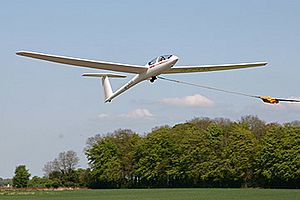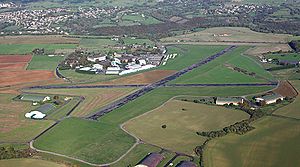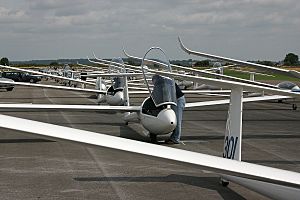Cotswold Gliding Club facts for kids
The Cotswold Gliding Club (CGC) is a special place where people learn to fly gliders. It is located at Aston Down airfield, which is between the towns of Cirencester and Stroud in Gloucestershire, South West England. The club has many aircraft for training new pilots. It is also a well-known spot for cross-country gliding and exciting competitions.
Contents
How the Cotswold Gliding Club Started
The Cotswold Gliding Club began in 1964. At first, it was based at Long Newnton airfield near Tetbury. But in 1967, the club moved to its current home, Aston Down. Back then, Aston Down was still a military airfield.
In 1980 and 1981, the club bought a large part of the airfield. They got help from grants and loans to do this. The land was sold by the Ministry of Defence. Since then, CGC has bought even more land. Now, the club owns most of the airfield inside its main boundary.
The club has about 150 members. It also welcomes students from the University of the West of England (UWE) in Bristol. Other members include pilots with limited flying rights and aeromodellers, who fly model planes. There are also social members who enjoy the club's atmosphere. In 2007, the CGC also started including Blokarters, who use special land yachts.
Exploring Aston Down Airfield
Aston Down is a very large airfield, especially for gliding. Its main runway is 1500 meters (about one mile) long. This long runway allows gliders to be launched very high, usually between 450 and 700 meters (1,500 to 2,300 feet). Sometimes, launches can even reach up to 900 meters (3,000 feet) when the wind is blowing straight down the runway.
For many years, gliders at Aston Down were launched using a method called reverse pulley. However, since the year 2000, the main way to launch gliders has been by winch. These high launches make it easy for gliders to find thermals. Thermals are rising currents of warm air that come from the well-drained Cotswold limestone hills. These conditions are perfect for soaring, which is when gliders stay in the air without an engine.
Aerotow launching is also becoming more common. This method is often used during competitions. It is also helpful when westerly or north-westerly winds create lift from the Cotswold ridge, also known as the "Edge." Sometimes, gliders can even catch wave lift that comes from the Welsh mountains.
The picture shows Aston Down from the south. The main runway runs from the bottom left to the top right. There is also a shorter 1000-meter (3,300 feet) east-west runway. An old, unused runway in the distance has been partly removed. This gives more space for gliders to land on the grass. Blokarting and aeromodelling activities happen on the runway that is not being used for gliding at that time.
Gliders at the Club

The Cotswold Gliding Club has a great collection of aircraft. These are used for training and for members to fly.
- Two ASK-21 gliders: These are two-seat gliders used for all-around training.
- A DG 500: This is an advanced two-seat glider. It is used for cross-country training and can also be used for aerobatics training.
- An ASK-13: Another two-seat glider used for training.
- An ASK-23: This glider is available for pilots who have just flown solo for the first time.
- A Sport Vega: This glider is for more experienced solo pilots.
The club also has some access to gliders owned by the UWE Gliding Club. These include another ASK-13 and a Ka8 for solo pilots. All the club's gliders have similar instruments. They are also equipped with audio variometers, which tell pilots if they are going up or down.
What Happens at the Gliding Club
The Cotswold Gliding Club is very active. During the soaring season, which runs from April to September, the club operates seven days a week. In the winter months, they fly on Wednesdays and at weekends.
If you are interested in gliding, you can book a trial lesson. You can also sign up for more intense one-day courses or five-day courses. For groups like work parties or other clubs, special flying sessions are held on Tuesday and Thursday evenings in the summer.
In 2008, the club started offering courses specifically for power pilots. These courses give them a chance to try soaring flight firsthand.
Club members receive training from about 30 instructors. These instructors are qualified by the BGA. The training helps pilots fly solo and beyond, even to advanced cross-country flying. Some members own private motor gliders based at Aston Down. These are available for club members to practice field landing and cross-country checks.
During the soaring season, many members fly their own private gliders. These are often owned by two or more partners. They enjoy local soaring or go on longer cross-country flights, sometimes covering hundreds of kilometers. You can see examples of recent flights by club members on the BGA Ladder website.
Gliding Competitions
Competitions at Aston Down
Aston Down is a popular place to host regional and national gliding competitions. This is because it has excellent runways and facilities. As early as 1962, the National Gliding Championships were held here. The UK's first ever 300-kilometer task was set during that competition.
The Cotswold Gliding Club has hosted many competitions, including:
- 2004 Standard Class Nationals (shown in the picture)
- 2004 Competition Enterprise
- 2006 15 Metre Nationals
- 2007 Inter University Task Week
- 2008 Club Class Nationals
- 2009 15 Metre Nationals
- 2010 Open Class and Standard Class Nationals
- 2011 Junior Championships
- 2013 Open Class & Standard Class Nationals
- 2015 Junior Nationals and Cotswold Regionals
- 2016 20m Multi-Seat and Standard Class Nationals
- 2017 Standard, Open, 15m & 20m Multi-Seat Nationals
- 2018 Standard, Open & 15m Nationals
- 2019 Club Class Nationals
- 2021 Junior Nationals and Cotswold Regionals
- 2022 Standard, Open & 15m Nationals
- 2023 Cotswold Regionals
- 2024 Standard, Open & 15m Class Nationals
- 2025 Junior Nationals and Cotswold Regionals
- 2025 Competition Enterprise
Competitions at Other Places
Pilots from the Cotswold Gliding Club often take part in regional and national competitions. They also join informal competitions, such as:
- Rockpolishers League: This is a friendly group of six local gliding clubs. They organize fun cross-country competitions.
- Two Seater Competition at Pocklington: In 2007, the club's DG 500 and a private Duo Discus from Aston Down competed. They finished 15th and 5th out of 33 teams. In 2011, Duo Discus 572 won first place in the National two-seater championship.
- Competition Enterprise: In 2008, the same two gliders also took part in this competition. It was held at North Hill in Devon.
Other Sports at Aston Down
Aston Down is not just for gliding. In 2007, it hosted the British Blokart Championships. In July 2008, the Cotswold Cycle Racing League held its final race at Aston Down. It was a 30-kilometer race with six laps around the airfield.
Club Facilities
The original control tower at Aston Down has several useful rooms. It includes a briefing room, a club room, a kitchen, and places for people to stay overnight. There are also areas for caravans and camping on site.
A large hangar holds all the club's gliders. Most private gliders owned by members are stored in trailers or in a big, modern hangar when they are not being flown. There is also a workshop for keeping aircraft, vehicles, and winches in good condition.
The club has even built its own glider flight simulator. This helps members get more training opportunities.



